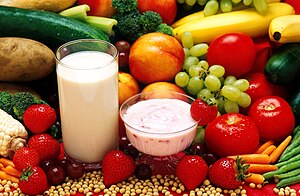Experts agree the key to healthy eating is the time-tested advice of balance, variety and moderation. In short, that means eating a wide variety of foods without getting too many calories or too much of any one nutrient. These 10 tips can help you follow that advice while still enjoying the foods you eat.
- Eat a variety of nutrient-rich foods. You need more than 40 different nutrients for good health, and no single food supplies them all. Your daily food selection should include bread and other whole-grain products; fruits; vegetables; dairy products; and meat, poultry, fish and other protein foods. How much you should eat depends on your calorie needs. Use the USDA's MyPlate and the Nutrition Facts panel on food labels as handy references.
- Enjoy plenty of whole grains, fruits and vegetables. Surveys show most Americans don't eat enough of these foods. Do you eat 6-11 servings from the bread, rice, cereal and pasta group, 3 of which should be whole grains? Do you eat 2-4 servings of fruit and 3-5 servings of vegetables? If you don't enjoy some of these at first, give them another chance. Look through cookbooks for tasty ways to prepare unfamiliar foods.
- Maintain a healthy weight. The weight that's right for you depends on many factors including your sex, height, age and heredity. Excess body fat increases your chances for high blood pressure, heart disease, stroke, diabetes, some types of cancer and other illnesses. But being too thin can increase your risk for osteoporosis, menstrual irregularities and other health problems. If you're constantly losing and regaining weight, a registered dietitian can help you develop sensible eating habits for successful weight management. Regular exercise is also important to maintaining a healthy weight.
- Eat moderate portions. If you keep portion sizes reasonable, it's easier to eat the foods you want and stay healthy. Did you know the recommended serving of cooked meat is 3 ounces, similar in size to a deck of playing cards? A medium piece of fruit is 1 serving and a cup of pasta equals 2 servings. A pint of ice cream contains 4 servings. Refer to the Food Guide Pyramid for information on recommended serving sizes.
- Eat regular meals. Skipping meals can lead to out-of-control hunger, often resulting in overeating. When you're very hungry, it's also tempting to forget about good nutrition. Snacking between meals can help curb hunger, but don't eat so much that your snack becomes an entire meal.
- Reduce, don't eliminate certain foods. Most people eat for pleasure as well as nutrition. If your favorite foods are high in fat, salt or sugar, the key is moderating how much of these foods you eat and how often you eat them. Identify major sources of these ingredients in your diet and make changes, if necessary. Adults who eat high-fat meats or whole-milk dairy products at every meal are probably eating too much fat. Use the Nutrition Facts panel on the food label to help balance your choices. Choosing skim or low-fat dairy products and lean cuts of meat such as flank steak and beef round can reduce fat intake significantly. If you love fried chicken, however, you don't have to give it up. Just eat it less often. When dining out, share it with a friend, ask for a take-home bag or a smaller portion.
- Balance your food choices over time. Not every food has to be "perfect." When eating a food high in fat, salt or sugar, select other foods that are low in these ingredients. If you miss out on any food group one day, make up for it the next. Your food choices over several days should fit together into a healthy pattern.
- Know your diet pitfalls. To improve your eating habits, you first have to know what's wrong with them. Write down everything you eat for three days. Then check your list according to the rest of these tips. Do you add a lot of butter, creamy sauces or salad dressings? Rather than eliminating these foods, just cut back your portions. Are you getting enough fruits and vegetables? If not, you may be missing out on vital nutrients.
- Make changes gradually. Just as there are no "superfoods" or easy answers to a healthy diet, don't expect to totally revamp your eating habits overnight. Changing too much, too fast can get in the way of success. Begin to remedy excesses or deficiencies with modest changes that can add up to positive, lifelong eating habits. For instance, if you don't like the taste of skim milk, try low-fat. Eventually you may find you like skim, too.
- Remember, foods are not good or bad. Select foods based on your total eating patterns, not whether any individual food is "good" or "bad." Don't feel guilty if you love foods such as apple pie, potato chips, candy bars or ice cream. Eat them in moderation, and choose other foods to provide the balance and variety that are vital to good health.





